A Tundra Swan At The Susquehanna River Lands! You Never Know What You Will Find Down Here

I returned to the Susquehanna Wetlands in Salem Township, Luzerne County on Sunday. It’s Spring and I hoped to see some wildlife activity. As usual I was hoping to see, and photograph, the bald eagles, wood ducks, river otters and many other critters that live here. On Friday I was surprised to see the snapping turtles mating . I always expect the to be surprised on my hikes here but I wasn’t expecting to see a tundra swan. These graceful birds should have already migrated to their breeding grounds in the Canadian Arctic this late in March. Well, one didn’t. More about this unusual sighting later.
It was a seasonably cool, cloudy and raw day when I arrived at the wetlands with temperatures in the low 40’s,As usual I walked to the banks of the Susquehanna River hoping to see an eagle, osprey or some water fowl. There weren’t any on Sunday. 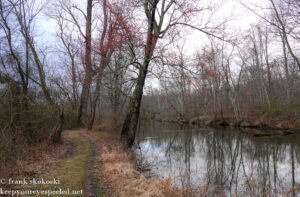
I walked into the wetlands and saw a welcome sight. The red maples trees were beginning to bud. 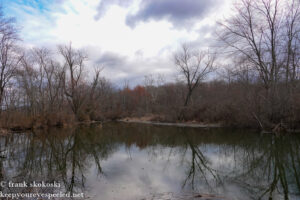
The spring peeper frogs were quiet because of the cool temperatures but I heard a couple of other sounds of Spring. The shrill nasal sounds of the red-winged blackbirds perched in the tree tops echoed in the wetlands,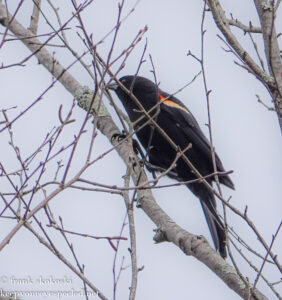
as did the loud honking sounds of the Canada geese defending their nesting territories. 
A few wood ducks flew off one of the ponds before I could get a photo. These elusive ducks have been able to avoid my camera since they arrived here a few weeks ago. 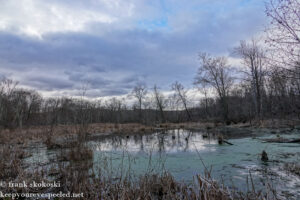
There were no ducks on the water fowl pond so I made my way toward the river lands. On the way I saw a pair of red-bellied woodpeckers searching for insects under the bark of a dead tree. It appeared the one was last year’s juvenile and still tagging along with it’s parent. 
A few black-capped chickadees were also fluttering in the tree branches along the trail .
.
This week, in addition to the skunk cabbages sprouting along the trail, there were more plants sprouting in the woodlands of the wetlands, including the garlic mustard and,
and Dames’s rocket. It was good to see green leaves again. Although Dame’s rocket produces beautiful flowers and garlic mustard is edible both of these plants are invasive and are endangering native plants. 
Walking through the wetlands I saw a few wood ducks that quickly flew away before I could get a photo. It was an overcast and dreary day as I walked toward the river again. At the river I saw the flock of common mergansers on the far shore, but, because of the clouds and poor light didn’t take any photos.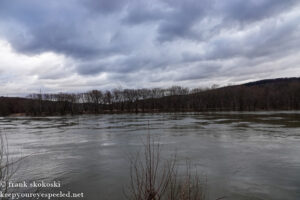
I left the river and now walked to Lake Took-A While in the river lands area of the preserve. On my way I saw a few American robins and, 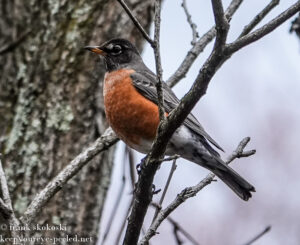
some northern cardinals that were singing in the treetops, and 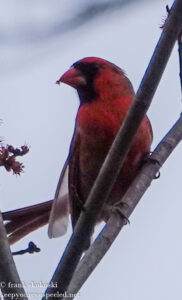
a Carolina wren was singing loudly along the trail. 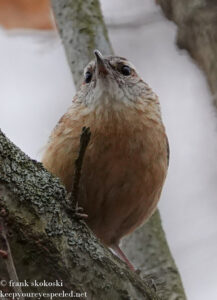
When I reached the the river lands I saw some Canada geese on Lake Took-A- While and a flock of common mergansers. 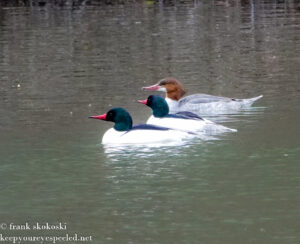
The clouds reflecting off of the lake made for some nice photos.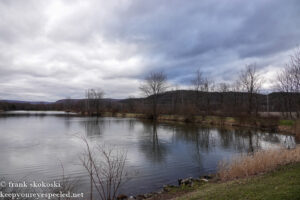
As usual I walked to the end of the lake.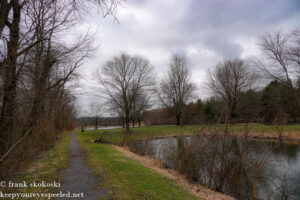
On the way a passing fisherman and his son told me of a swan in the field on the other side of the entrance road. I walked to the field to investigate and found this juvenile tundra swan feeding in a corn field.
This was an unusual sight for a number of reasons. First, these beautiful and graceful birds migrate in large flocks from the Mid-Atlantic coastal areas where the spend the Winter to their breeding grounds in the Arctic tundra. They never migrate alone. 
They also migrate much earlier in March, and usually rest and feed on larger lakes on their migration routes. I have never seen one anywhere near the wetlands or Susquehanna River before. This juvenile must have been injured or somehow got separated from it’s flock. After seeing me approach it wandered over to a small puddle in the corn field. And even more unusual it was hanging out with a mallard duck. 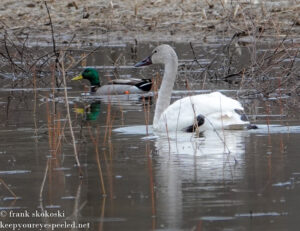
It was nice to see this beautiful bird but am hoping it leaves our area and finds it’s way to the Arctic and joins the rest of it’s flock. 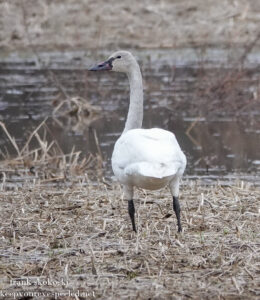
I headed back to the wetlands under the overcast and dreary skies. On the way I saw a few more birds, some song sparrows, 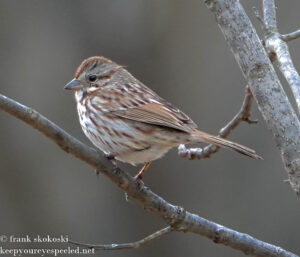
this northern mockingbird, one of my dad’s and my favorites, 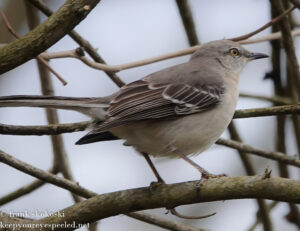
a great blue heron that flew over the lake,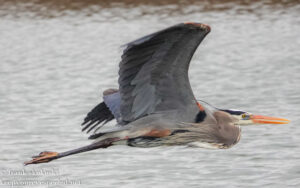
it’s good to see the water fowl returning to the wetlands and river lands. 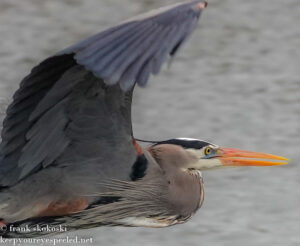
And I finally was able to get a not so good photo of the elusive kingfisher that has returned to the river lands. Here is a link to a gallery with some more photographs of the birds and tundra swan I saw in the wetlands and river lands. Susquehanna River birds March 20 2022. 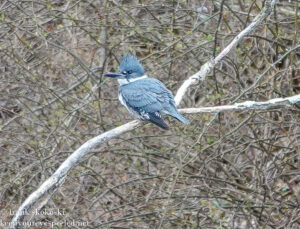
I finished my hike in the wetlands,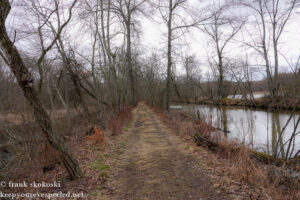
walking past the many skunk cabbage poking through the muddy soil. 
Although I didn’t see the eagles, otters, and other wildlife I hoped to see, the wetlands again provided me with an opportunity to see the juvenile tundra swan. There is always something to see in this natural refuge along the ancient Susquehanna River. Here is a link to a gallery with some more photos from my hike in the wetlands and river lands. Susquehanna Wetlands March 20 2022, 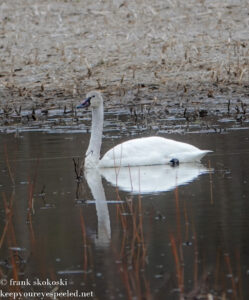
“If you can add a great beauty to something which is already beautiful, then you must be very beautiful like a white swan adding beauty to a misty lake!”
―
Categories
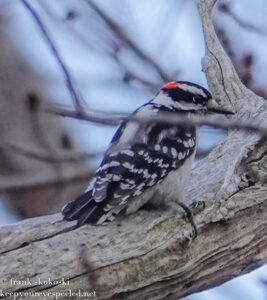
Beautiful photos and very enjoyable commentary!
I would like to add one comment on the subject of the Dame’s Rocket which, unfortunately, has had a derogatory label attached to it as ‘invasive’. There are plenty more obnoxious invasive species I can think of, one example being the skunk cabbage [in my opinion], but no other wild plant can lay claim to producing one of the most beautiful smells anywhere.
I have lived across the road from wetlands [fed into by an underground spring flowing beneath my property, which then feeds into the headwaters of the Little Lehigh Creek] since October 1987 and am blessed every May with their wonderful odor. The delicate flowers, at the top of a tall plant, range in color from white thru variations of lavender.
I would certainly like to know what native plants they have edged out; but, thankfully, they
still exist and, hopefully, always will; at least as long as I am alive.
Thank you again for your photography and your very interesting, informative blogs.
Thanks and I now agree with your comment on Dames Rocket. It is a beautiful flower.